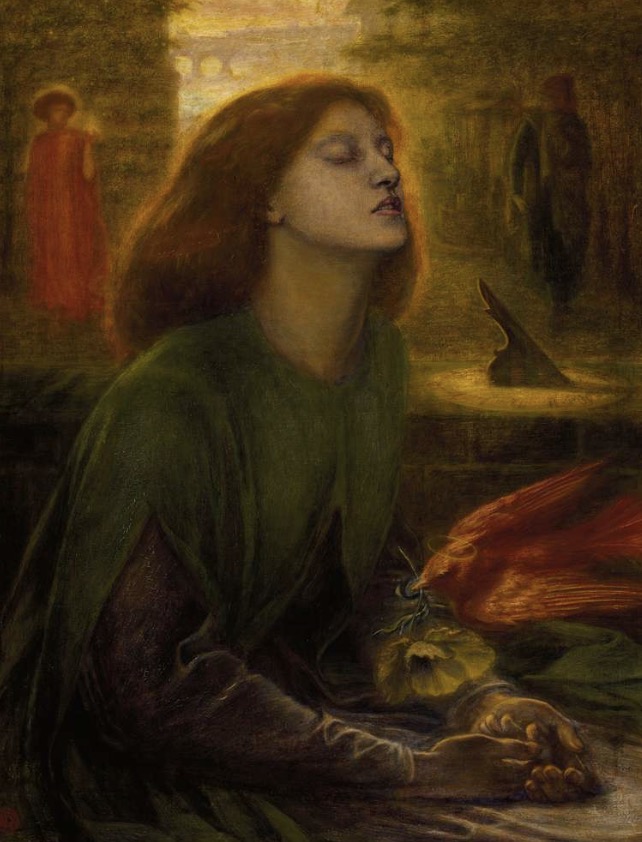The Pre-Raphaelite Brotherhood, a group of 19th-century British painters, emerged as a reaction to the academic art of their time. Comprising a small yet influential circle of artists, the Pre-Raphaelites sought to return to the techniques and styles of the Italian painters who preceded Raphael, thus the name “Pre-Raphaelite.” Their art is characterized by intricate detail, vivid colors, and a penchant for medieval themes. In this article, we will delve into the world of Pre-Raphaelite paintings, exploring the lives and works of some of the most famous painters of the movement.
Reader's Roadmap
1. Dante Gabriel Rossetti and “Beata Beatrix” (1864)
Dante Gabriel Rossetti was one of the founding members of the Pre-Raphaelite Brotherhood. His painting “Beata Beatrix” is a poignant representation of Dante Alighieri’s beloved, Beatrice. The piece beautifully captures the ethereal quality of his muse, with intricate detailing and rich colors that are characteristic of the Pre-Raphaelite style.
2. John Everett Millais and “Ophelia” (1851)
John Everett Millais, another prominent Pre-Raphaelite artist, is best known for his hauntingly beautiful painting “Ophelia.” This masterpiece depicts the tragic Shakespearean character floating in a river. The attention to detail in the flora and the serene depiction of Ophelia’s demise make it an iconic work of the movement.
3. William Holman Hunt and “The Light of the World” (1853-1854)
William Holman Hunt’s “The Light of the World” is a deeply religious painting that showcases his meticulous attention to detail. The image of Christ knocking at a door illuminated by a lantern symbolizes spiritual awakening. It remains one of the most recognizable Pre-Raphaelite works.
4. Ford Madox Brown and “Work” (1852-1865)
Ford Madox Brown’s “Work” is a monumental painting that portrays Victorian society’s diverse labor force. The intricate composition and the portrayal of various social classes at work make it a significant social commentary and a striking Pre-Raphaelite masterpiece.
5. Edward Burne-Jones and “The Golden Stairs” (1880)
Edward Burne-Jones, closely associated with the second phase of the Pre-Raphaelite movement, created “The Golden Stairs.” This dreamlike painting features a group of women descending a golden staircase, their faces serene and enigmatic, representing the movement’s fascination with mythical and allegorical subjects.
6. John William Waterhouse and “Boreas” (1903)
John William Waterhouse, while not one of the original Pre-Raphaelite Brotherhood members, was heavily influenced by their style and themes. In his art work “Boreas” (1903), Waterhouse captures the god of the north wind in a moment of fierce determination. The work showcases his mastery of Pre-Raphaelite techniques, with vivid colors and intricate details that bring mythology to life.
7. John William Waterhouse and “The Lady of Shalott” (1888)
Another iconic painting by John William Waterhouse is “The Lady of Shalott” (1888), inspired by Lord Alfred Tennyson’s poem. The artwork depicts the tragic fate of the lady in the tower. Waterhouse’s attention to detail and the atmospheric quality of the painting make it a classic example of Pre-Raphaelite art.
8. John William Waterhouse and “Hylas and the Nymphs” (1896)
“Hylas and the Nymphs” (1896) is yet another remarkable work by John William Waterhouse. The painting portrays the Greek myth of Hylas, who is lured by nymphs into a pond. Waterhouse’s depiction of the myth is both sensual and enchanting, emphasizing the Pre-Raphaelite fascination with mythology and sensuality.
9. John William Waterhouse and “The Lady of Shalott” (1916)
Waterhouse revisited “The Lady of Shalott” in 1916, creating another mesmerizing version of the same theme. The ethereal beauty of the lady and the delicate detailing of the tapestry are typical of Waterhouse’s mastery of the Pre-Raphaelite style.
10. Frederick Sandys and “Morgan le Fay” (1864)
Frederick Sandys, though not an official member of the Pre-Raphaelite Brotherhood, was associated with the movement. His painting “Morgan le Fay” is a stunning portrayal of the Arthurian sorceress. The vibrant colors and meticulous rendering of Morgan le Fay’s attire exemplify the Pre-Raphaelite aesthetic.
11. John Brett and “Val d’Aosta” (1858)
John Brett was known for his breathtaking landscapes, and “Val d’Aosta” is a prime example. The painting showcases the natural world with stunning precision and a reverence for detail, reflecting the Pre-Raphaelite commitment to capturing the beauty of the world with vivid clarity.
12. Arthur Hughes and “The Long Engagement” (1854)
Arthur Hughes, a friend of the Pre-Raphaelites, contributed to the movement with works like “The Long Engagement.” This romantic painting portrays a tender moment between a soldier and his beloved. The emotional depth and intricate rendering of fabrics reveal the Pre-Raphaelite influence.
13. William Morris and His Contribution to the Pre-Raphaelite Aesthetic
While William Morris is primarily known for his textile designs and involvement in the Arts and Crafts Movement, his collaboration with Pre-Raphaelite artists, particularly Dante Gabriel Rossetti, contributed to the movement’s overall aesthetic. Morris’s intricate and nature-inspired patterns became synonymous with the Pre-Raphaelite style.
14. The Second Phase of the Pre-Raphaelite Brotherhood
After the initial formation of the Pre-Raphaelite Brotherhood, some artists like Burne-Jones and William Morris continued to explore Pre-Raphaelite themes and techniques in the second phase of the movement. This period saw a further emphasis on mythological and allegorical subjects.
15. The Influence of Literature on Pre-Raphaelite Art
One of the defining features of Pre-Raphaelite art was its close relationship with literature. The artists often drew inspiration from poetry, myths, and legends, creating visual interpretations that added depth and nuance to their work.
16. The Impact of Pre-Raphaelite Art on Victorian Society
The Pre-Raphaelite Brotherhood’s rejection of academic norms and embrace of vivid colors and intricate details had a significant impact on the art world of their time. Their works challenged traditional aesthetics and opened up new avenues for artistic expression.
17. The Legacy of Pre-Raphaelite Art in the 21st Century
The influence of Pre-Raphaelite art can still be seen in contemporary art and culture. Its emphasis on detailed craftsmanship and storytelling continues to inspire artists, designers, and filmmakers today.
18. The Enduring Appeal of Pre-Raphaelite Paintings
The enduring appeal of Pre-Raphaelite paintings lies in their ability to transport viewers to a world of beauty, romance, and symbolism. Their intricate details and dreamlike quality continue to captivate art enthusiasts around the world.
19. The Pre-Raphaelite Women: Models and Musas
Many Pre-Raphaelite paintings featured women as central figures. Some of these women, like Jane Morris and Elizabeth Siddal, played essential roles as models, muses, and artists in their own right within the Pre-Raphaelite circle.
20. The Pre-Raphaelite Brotherhood’s Influence on Symbolism
The Pre-Raphaelite Brotherhood’s fascination with symbolism and allegory paved the way for the Symbolist movement in art, which further explored the use of symbolism and dreamlike elements in visual art.
21. The Pre-Raphaelite Collections in Museums and Galleries
Pre-Raphaelite art can be found in many museums and galleries worldwide. These collections allow art lovers to experience the beauty and intricacy of the movement up close.
22. Rediscovering the Pre-Raphaelites: A Contemporary Perspective
In recent years, there has been a renewed interest in the Pre-Raphaelites, with exhibitions and publications exploring their work and legacy from a contemporary standpoint.
23. Pre-Raphaelite Art and Its Place in Art History
The Pre-Raphaelite Brotherhood occupies a unique place in the history of art. They challenged conventions, inspired new movements, and left behind a body of work that continues to enchant and captivate audiences.
24. Conclusion: A Timeless Legacy of Beauty and Romance
In conclusion, the Pre-Raphaelite Brotherhood, with its vibrant colors, attention to detail, and exploration of myth and symbolism, has left an indelible mark on the world of art. The works of Rossetti, Millais, Hunt, Waterhouse, and their contemporaries continue to inspire and captivate, reminding us of the enduring power of beauty and romance in art.







Leave a Reply
View Comments